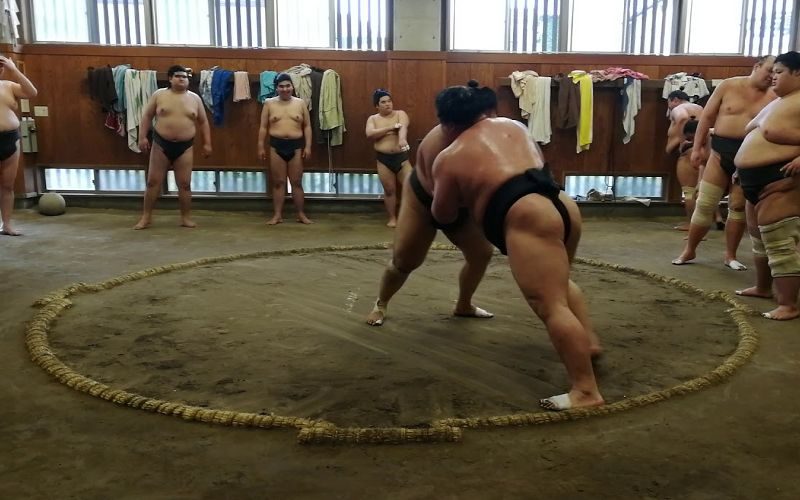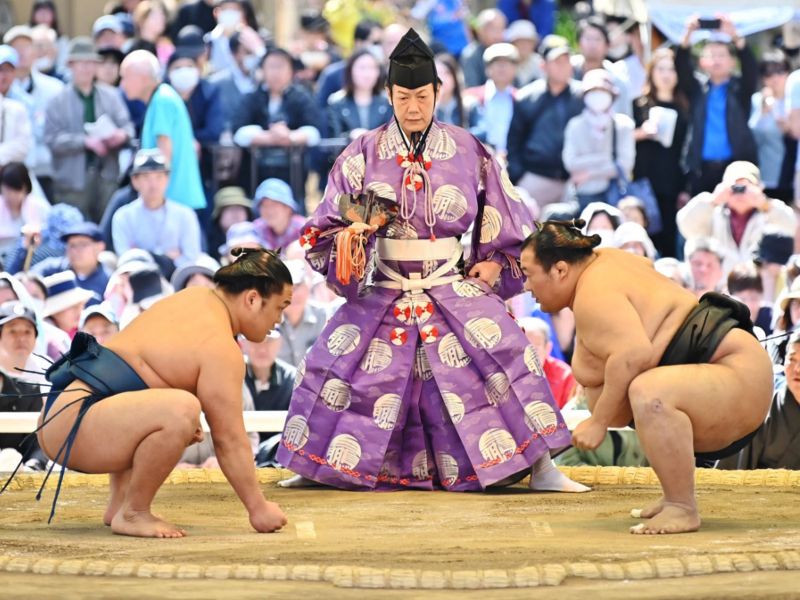Sumo wrestling is considered to be Japan’s national sport and it’s a huge hit with tourists. It’s a fantastic spectacle which offers unique insights into Japanese culture as it has been performed ever since the ancient Shinto period.
There are many places to see sumo wrestling in Japan though the best way is to catch one of the spectacular sumo tournaments. The competitions normally last around 15 days and feature the biggest and best sumo wrestlers in Japan.
You can buy tickets directly from the stadiums or from a number of authorized outlets. There are also many smaller events where you can see sumo wrestling. This guide will explain in detail where and when you can see the iconic sport in action.
Table of Contents
Sumo wrestling rules
The rules of sumo wrestling are fairly simple. The wrestlers try to force each other out of the ring (known as a dohyo) and the first person to touch the ground (with a body part other than the soles of their feet) or to get forced out of the ring loses. Contests are often over in a matter of seconds though some can last over a minute.
There are no weight divisions in sumo wrestling which means that wrestlers can face an opponent who is much heavier. However, superior technique and speed often triumphs over weight.
There are also a number of less common rules in sumo wrestling. Wrestlers can lose if they use an illegal technique (known as a kinjite) and wrestlers who fail to turn up to a bout automatically lose.
Where and when to see sumo wrestling
The best way is to catch an official basho (sumo tournament). The are 6 events a year held in various locations around Japan. You can also see some of the country’s top wrestlers at exhibitions which are held between the tournaments.
Basho tournaments: dates and locations
The first basho tournament of the sumo season take place in January and the last happens in November. Half of the sumo tournaments are in Tokyo. Osaka, Nagoya, and Fukuoka all host one tournament a year each.

Each tournament lasts 15 days and starts and ends on a Sunday. Here is a list of the venues and months of the tournaments (the exact dates vary from year to year).
- January – Hatsu Basho Tournament (Tokyo)
- March – Haru Basho Tournament (Osaka)
- May – Natsu Basho Tournament (Tokyo)
- July – Nagoya Basho Tournament (Nagoya)
- September – Aki Basho Tournament (Tokyo)
- November – Kyushu Basho Tournament (Fukuoka)
Other places in Japan to see sumo wrestling
There are other ways of seeing sumo wrestling in Japan besides the major tournaments. Regular exhibitions are held between the tournaments and you can also visit a sumo beya (heya), where the wrestlers live and train.

Sumo wrestlers wake up very early so you have to go in the morning to see them training and sparring with each other. To observe the sumo training sessions you normally have to sit on the floor and respect the fighters by being silent while they carry out their rituals.
Booking seats for sumo tournaments
Just as like any other sports venue, there are different types of seats which vary in how close they are to the ring and how expensive they are. The big tournaments often sell out around a month before the event so it is recommended to buy your tickets as early as possible. Some sumo tickets are normally reserved for people who turn up on the day.
Ringside seats
These are the best seats in the house. However, they are also the most expensive and difficult ones to get! Spectators in these seats are very close to the action, so close that some have been accidentally injured by wrestlers in the past.
Box seats
Box seats are also highly sought-after. They generally seat 4 people although they are some which are bigger or smaller. Tickets are sold for entire boxes regardless which means that this is can be an expensive option if you’re going alone or with just one other person.
Balcony seats
Balcony seats are classified as A, B, or C seats depending on how close they are to the ring. There is normally a section of balcony seats reserved which visitors can buy on the day. Even if an event is sold out, some of the seats are kept aside for the actual day.

Ryogoku district: Home of sumo wrestling
Aside from competitions, there are other places tourists can visit to get a flavor of sumo wrestling. Tokyo’s Ryogoku district is the home the sport and there are many ‘sumo stables’ which are open to visitors. The Ryogoku Kokugikan Stadium is also located here.
From Tokyo Station to Ryogoku, you can take the Yamanote line to Akihabara Station, then transfer to Sobu line to Ryogoku Station.
Here are some other popular sumo attractions located in the district:
Sumo Museum
The Sumo Museum, located in The Ryogoku Kokugikan Stadium, exhibits a number of rare items including portraits of famous wrestlers, pictures of significant events from the sport’s history, and ceremonial clothes. Admission to the museum is free but during the big Tokyo tournaments, only tournament ticket holders can access the museum.
Tomioka Hachimangu Shrine
The Tomioka Hachimangu Shrine is the place where sumo tournaments took place during the Edo Period (1603-1867). Today you can see the names of past sumo champions inscribed in the monuments and visit the treasure house which contains sumo-related relics such as prints and publications.
Chanko nabe restaurants

Chanko nabe is the staple food of sumo wrestlers and there are numerous restaurants in Ryogoku where you can sample the delicious hot pie. There are many varieties of the classic dish, some contain just vegetables whereas others also have seafood and meat. The restaurants also serve lighter snacks, bento boxes (Japanese lunch boxes), and drinks.
